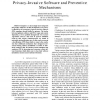Free Online Productivity Tools
i2Speak
i2Symbol
i2OCR
iTex2Img
iWeb2Print
iWeb2Shot
i2Type
iPdf2Split
iPdf2Merge
i2Bopomofo
i2Arabic
i2Style
i2Image
i2PDF
iLatex2Rtf
Sci2ools
ICSNC
2006
IEEE
2006
IEEE
Privacy-Invasive Software and Preventive Mechanisms
Computers are increasingly more integrated into peoples’ daily lives. In this development, user privacy is affected by the occurrence of privacy-invasive software (PIS), sometimes loosely labelled as spyware. The border between legitimate software and PIS is vague and context dependent, at best specified through End User License Agreements (EULA). This lack of spyware definition result in that current countermeasures are bound to noticeable misclassification rates. In this work we present a classification of PIS from which we come to the conclusion that additional mechanisms that safeguard users’ consent during software installation is needed, to effectively counteract PIS. We further present techniques that counteract PIS by increasing user awareness about software behaviour, which allow users to base their software installation consent on more informed decisions.
| Added | 11 Jun 2010 |
| Updated | 11 Jun 2010 |
| Type | Conference |
| Year | 2006 |
| Where | ICSNC |
| Authors | Martin Boldt, Bengt Carlsson |
Comments (0)

